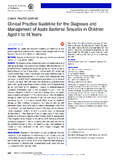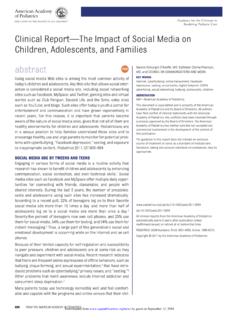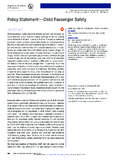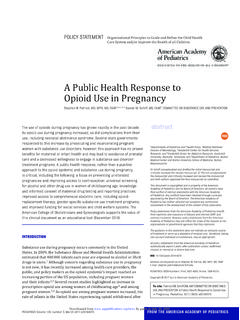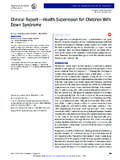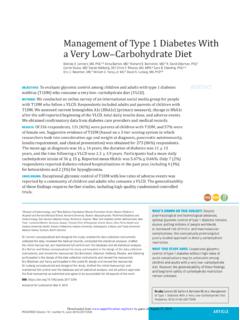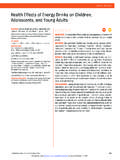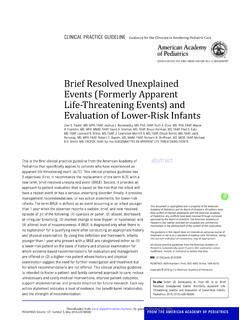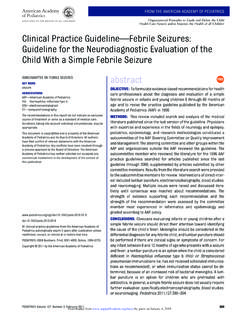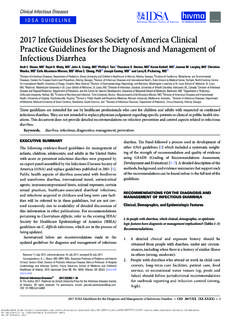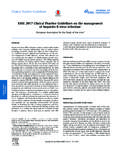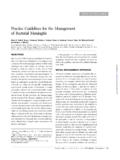Transcription of CLINICAL PRACTICE GUIDELINE …
1 CLINICAL PRACTICE GUIDELINEC linical PRACTICE GUIDELINE : The Diagnosis, Management,and Prevention of BronchiolitisabstractThis GUIDELINE is a revision of the CLINICAL PRACTICE GUIDELINE , Diagnosisand Management of Bronchiolitis, published by the American Academyof Pediatrics in 2006. The GUIDELINE applies to children from 1 through23 months of age. Other exclusions are noted. Each key action state-ment indicates level of evidence, benefit-harm relationship, and levelof recommendation. Key action statements are as follows:Pediatrics2014;134:e1474 e1502 DIAGNOSIS1a. Clinicians should diagnose bronchiolitis and assess disease se-verity on the basis of history and physical examination (EvidenceQuality: B; Recommendation Strength: Strong Recommendation).
2 1b. Clinicians should assess risk factors for severe disease, such asage less than 12 weeks, a history of prematurity, underlying car-diopulmonary disease, or immunodeficiency, when making decisionsabout evaluation and management of children with bronchiolitis(Evidence Quality: B; Recommendation Strength: Moderate Rec-ommendation).1c. When clinicians diagnose bronchiolitis on the basis of history andphysical examination, radiographic or laboratory studies shouldnot be obtained routinely (Evidence Quality: B; RecommendationStrength: Moderate Recommendation).TREATMENT2. Clinicians should not administer albuterol (or salbutamol) to in-fants and children with a diagnosis of bronchiolitis (Evidence Qual-ity: B; Recommendation Strength: Strong Recommendation).
3 3. Clinicians should not administer epinephrine to infants and childrenwith a diagnosis of bronchiolitis (Evidence Quality: B; Recommen-dation Strength: Strong Recommendation).4a. Nebulized hypertonic saline should not be administered to in-fants with a diagnosis of bronchiolitis in the emergency depart-ment (Evidence Quality: B; Recommendation Strength: ModerateRecommendation).4b. Clinicians may administer nebulized hypertonic saline to infantsand children hospitalized for bronchiolitis (Evidence Quality: B;Recommendation Strength: Weak Recommendation [based on ran-domized controlled trials with inconsistentfindings]).Shawn L. Ralston, MD, FAAP, Allan S. Lieberthal, MD, FAAP,H. Cody Meissner, MD, FAAP, Brian K. Alverson, MD, FAAP, Jill , MD, FAAP, Anne M.
4 Gadomski, MD, MPH, FAAP,David W. Johnson, MD, FAAP, Michael J. Light, MD, FAAP,Nizar F. Maraqa, MD, FAAP, Eneida A. Mendonca, MD, PhD,FAAP, FACMI, Kieran J. Phelan, MD, MSc, Joseph J. Zorc, MD,MSCE, FAAP, Danette Stanko-Lopp, MA, MPH, Mark , MD, Ian Nathanson, MD, FAAP, ElizabethRosenblum, MD, Stephen Sayles III, MD, FACEP, and SinsiHernandez-Cancio, JDKEY WORDS bronchiolitis, infants, children, respiratory syncytial virus,evidence-based, guidelineABBREVIATIONSAAP American Academy of PediatricsAOM acute otitis mediaCI confidence intervalED emergency departmentKAS Key Action StatementLOS length of stayMD mean differencePCR polymerase chain reactionRSV respiratory syncytial virusSBI serious bacterial infectionThis document is copyrighted and is property of the AmericanAcademy of Pediatrics and its Board of Directors.
5 All authors havefiled conflict of interest statements with the American Academy ofPediatrics. Any conflicts have been resolved through a processapproved by the Board of Directors. The American Academy ofPediatrics has neither solicited nor accepted any commercialinvolvement in the development of the content of this recommendations in this report do not indicate an exclusivecourse of treatment or serve as a standard of medical care. Variations,taking into account individual circumstances, may be CLINICAL PRACTICE guidelines from the American Academy ofPediatrics automatically expire 5 years after publication unlessreaffirmed, revised, or retired at or before that to the memory of Dr Caroline Breese (ISSN Numbers: Print, 0031-4005; Online, 1098-4275).
6 Copyright 2014 by the American Academy of Pediatricse1474 FROM THE AMERICAN ACADEMY OF PEDIATRICSG uidance for the Clinician inRendering Pediatric Care by guest on August 1, from 5. Clinicians should not administersystemic corticosteroids to infantswith a diagnosis of bronchiolitis inany setting (Evidence Quality: A; Rec-ommendation Strength: Strong Rec-ommendation).6a. Clinicians may choose not to ad-minister supplemental oxygen ifthe oxyhemoglobin saturation ex-ceeds 90% in infants and childrenwith a diagnosis of bronchiolitis(Evidence Quality: D; Recommen-dation Strength: Weak Recommen-dation [based on low level evidenceand reasoning fromfirst princi-ples]).6b. Clinicians may choose not to usecontinuous pulse oximetry for in-fants and children with a diagnosisof bronchiolitis (Evidence Quality:D; Recommendation Strength: WeakRecommendation [based on low-level evidence and reasoning fromfirst principles]).
7 7. Clinicians should not use chestphysiotherapy for infants and chil-dren with a diagnosis of bron-chiolitis (Evidence Quality: B;Recommendation Strength: Mod-erate Recommendation).8. Clinicians should not administerantibacterial medications to in-fants and children with a diagno-sis of bronchiolitis unless thereis a concomitant bacterial infec-tion, or a strong suspicion of one(Evidence Quality: B; Recommen-dation Strength: Strong Recom-mendation).9. Clinicians should administer naso-gastric or intravenousfluids forinfants with a diagnosis of bron-chiolitis who cannot maintain hy-dration orally (Evidence Quality: X;Recommendation Strength: StrongRecommendation).PREVENTION10a. Clinicians should not administerpalivizumab to otherwise healthyinfants with a gestational age of29 weeks, 0 days or greater(Evidence Quality: B; Recom-mendation Strength: StrongRecommendation).
8 10b. Clinicians should administerpalivizumab during thefirstyear of life to infants with he-modynamically significant heartdisease or chronic lung diseaseof prematurity defined as pre-term infants<32 weeks 0 days gestation who require>21%oxygen for at least thefirst28 days of life (Evidence Quality:B; Recommendation Strength:Moderate Recommendation).10c. Clinicians should administera maximum 5 monthly doses(15 mg/kg/dose) of palivizumabduring the respiratory syncytialvirus season to infants whoqualify for palivizumab in thefirst year of life (Evidence Quality:B; Recommendation Strength:Moderate Recommendation).11a. All people should disinfect handsbefore and after direct contactwith patients, after contact withinanimate objects in the directvicinity of the patient, and afterremoving gloves (Evidence Qual-ity: B; Recommendation Strength:Strong Recommendation).
9 11b. All people should use alcohol-based rubs for hand decontam-ination when caring for childrenwith bronchiolitis. When alcohol-based rubs are not available,individuals should wash theirhands with soap and water(Evidence Quality: B; Recom-mendation Strength: StrongRecommendation).12a. Clinicians should inquire aboutthe exposure of the infant orchild to tobacco smoke whenassessing infants and chil-dren for bronchiolitis (EvidenceQuality: C; RecommendationStrength: Moderate Recom-mendation).12b. Clinicians should counsel care-givers about exposing the in-fant or child to environmentaltobacco smoke and smokingcessation when assessing achild for bronchiolitis (EvidenceQuality: B; RecommendationStrength: Strong).13. Clinicians should encourage ex-clusive breastfeeding for at least6 months to decrease the mor-bidity of respiratory infections.
10 (Evidence Quality: B; Recommen-dation Strength: Moderate Rec-ommendation).14. Clinicians and nurses should ed-ucate personnel and family mem-bers on evidence-based diagnosis,treatment, and prevention in bron-chiolitis. (Evidence Quality: C; obser-vational studies; RecommendationStrength: Moderate Recommenda-tion).INTRODUCTIONIn October 2006, the American Acad-emy of Pediatrics (AAP) published theclinical PRACTICE GUIDELINE Diagnosisand Management of Bronchiolitis. 1 The GUIDELINE offered recommendationsranked according to level of evidenceand the benefit-harm relationship. Sincecompletion of the original evidence re-view in July 2004, a significant body ofliterature on bronchiolitis has beenpublished. This update of the 2006 AAPbronchiolitis GUIDELINE evaluates pub-lished evidence, including that used inthe 2006 GUIDELINE as well as evidencepublished since 2004.
